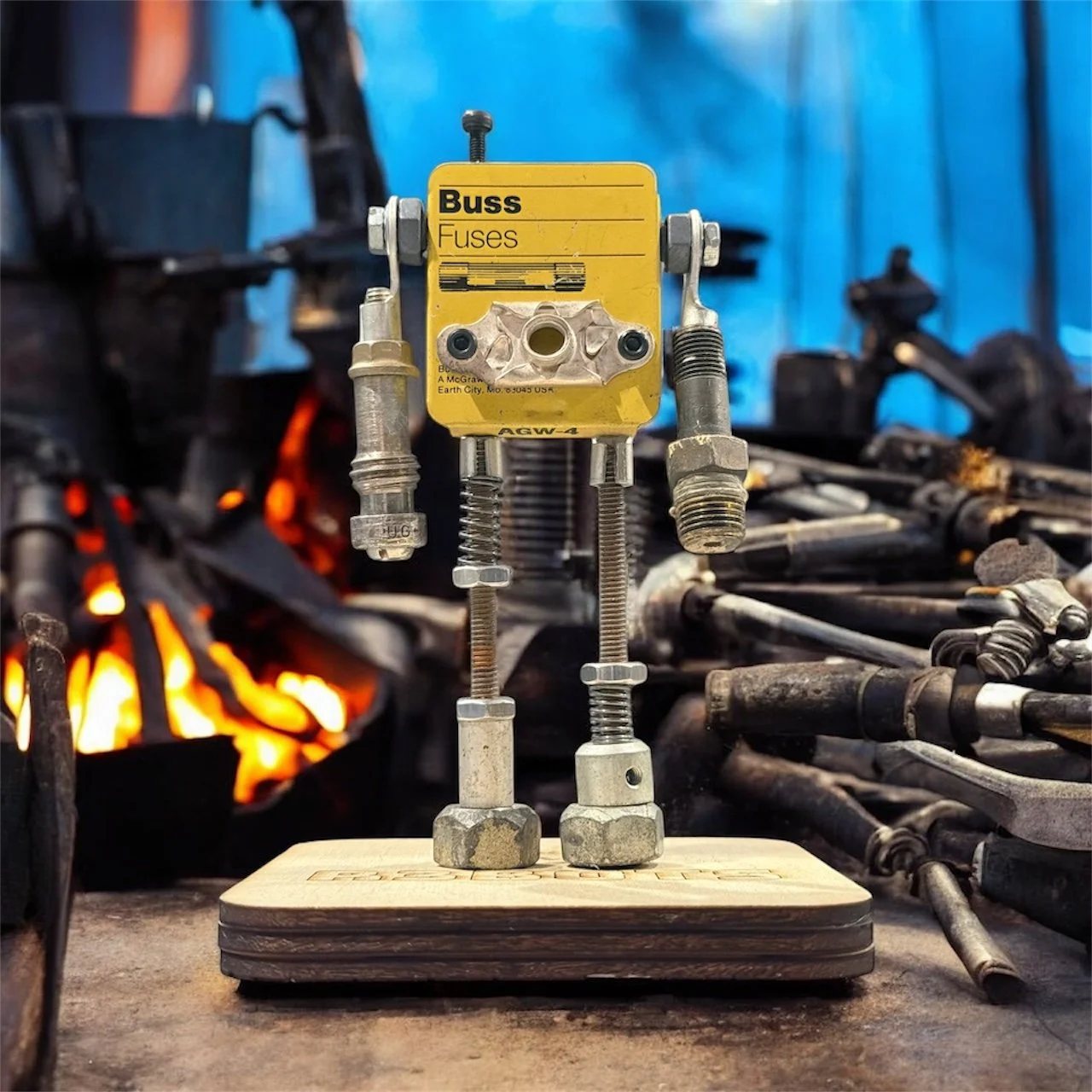 Image 1 of 1
Image 1 of 1


BF-4
FIELD OPS DOSSIER: UNIT BF-4 “THE BUSS RUNNER”
Division: Line Protection & Rapid Response
Height: 4.5 in
Status: Active
Serial: BF-4
Origin Classification: Industrial Fuse Relay / Phase I
I. Origins: The Yellow Shield
Long before it stood on a Field Ops baseplate, BF-4 lived its entire first life inside a Bussmann industrial fuse cabinet, mounted in a noisy manufacturing plant outside Earth City, Missouri.
The cabinet protected a set of heavy automation lines — conveyors, drill presses, and hydraulic cutters that ran hot and hard every day. When a fuse blew, the entire line went dark, costing the plant thousands per hour.
The small yellow block—now BF-4’s torso—was the central indicator module that told crews two things:
When a fuse had blown
Which line was in danger of surging again
Plant techs jokingly called it: “The Yellow Nervous System.”
This little module had seen every blackout, every surge, every close call.
II. Salvage: The Line Goes Dark
When the plant eventually shut down, most hardware was stripped for scrap. But the indicator module remained bolted inside the cabinet — forgotten, dust-covered, still holding faint charge in its metal edges.
A Field Ops recovery team clearing the facility noticed something strange:
Even after decades unplugged, the module’s worn black stripes still registered micro-resistance.
It had memory. Or something like it.
They removed it carefully, labeled it BF-4, and sent it to R3BOTS Lab.
III. Reconstruction: Compact & Fast
Engineers outfitted the fuse module with:
Rapid-deploy coil legs (for speed over uneven terrain)
Two asymmetrical relay arms — one built from an old fuse-body coupler, the other from a threaded conductor socket
A central surge-analysis node, using the original indicator plate’s sensing cavity
The result was a small, agile Field Ops unit with reflexes built for live circuits.
During activation, BF-4 immediately scanned the lab’s workbench, identified a miswired test rig, and flicked its right arm toward the faulty junction.
The lab’s diagnostics recorded its first output: “Line hazard detected.”
IV. Deployment: The Buss Runner
BF-4 quickly earned the nickname “The Buss Runner” for its uncanny speed at detecting and responding to surges during field exercises.
Where larger bots rely on processing time, BF-4 reacts by instinct — almost as if it’s still living inside that old fuse cabinet, monitoring a dozen lines at once.
Its duties include:
Surge scouting
Line integrity checks
Portable fuse deployment
Emergency bypass stabilization
Signal relaying between larger Field Ops units
Other bots often wait for BF-4’s call before entering hazardous zones.
To them, BF-4 isn’t just fast — it’s accurate.
V. Creed
Etched into the underside of its small baseplate:
“Before the overload… I’m there.”
R3BOTS FIELD OPS MOTTO
REPURPOSE. REBUILD. REINVENT.
FIELD OPS DOSSIER: UNIT BF-4 “THE BUSS RUNNER”
Division: Line Protection & Rapid Response
Height: 4.5 in
Status: Active
Serial: BF-4
Origin Classification: Industrial Fuse Relay / Phase I
I. Origins: The Yellow Shield
Long before it stood on a Field Ops baseplate, BF-4 lived its entire first life inside a Bussmann industrial fuse cabinet, mounted in a noisy manufacturing plant outside Earth City, Missouri.
The cabinet protected a set of heavy automation lines — conveyors, drill presses, and hydraulic cutters that ran hot and hard every day. When a fuse blew, the entire line went dark, costing the plant thousands per hour.
The small yellow block—now BF-4’s torso—was the central indicator module that told crews two things:
When a fuse had blown
Which line was in danger of surging again
Plant techs jokingly called it: “The Yellow Nervous System.”
This little module had seen every blackout, every surge, every close call.
II. Salvage: The Line Goes Dark
When the plant eventually shut down, most hardware was stripped for scrap. But the indicator module remained bolted inside the cabinet — forgotten, dust-covered, still holding faint charge in its metal edges.
A Field Ops recovery team clearing the facility noticed something strange:
Even after decades unplugged, the module’s worn black stripes still registered micro-resistance.
It had memory. Or something like it.
They removed it carefully, labeled it BF-4, and sent it to R3BOTS Lab.
III. Reconstruction: Compact & Fast
Engineers outfitted the fuse module with:
Rapid-deploy coil legs (for speed over uneven terrain)
Two asymmetrical relay arms — one built from an old fuse-body coupler, the other from a threaded conductor socket
A central surge-analysis node, using the original indicator plate’s sensing cavity
The result was a small, agile Field Ops unit with reflexes built for live circuits.
During activation, BF-4 immediately scanned the lab’s workbench, identified a miswired test rig, and flicked its right arm toward the faulty junction.
The lab’s diagnostics recorded its first output: “Line hazard detected.”
IV. Deployment: The Buss Runner
BF-4 quickly earned the nickname “The Buss Runner” for its uncanny speed at detecting and responding to surges during field exercises.
Where larger bots rely on processing time, BF-4 reacts by instinct — almost as if it’s still living inside that old fuse cabinet, monitoring a dozen lines at once.
Its duties include:
Surge scouting
Line integrity checks
Portable fuse deployment
Emergency bypass stabilization
Signal relaying between larger Field Ops units
Other bots often wait for BF-4’s call before entering hazardous zones.
To them, BF-4 isn’t just fast — it’s accurate.
V. Creed
Etched into the underside of its small baseplate:
“Before the overload… I’m there.”
R3BOTS FIELD OPS MOTTO
REPURPOSE. REBUILD. REINVENT.
